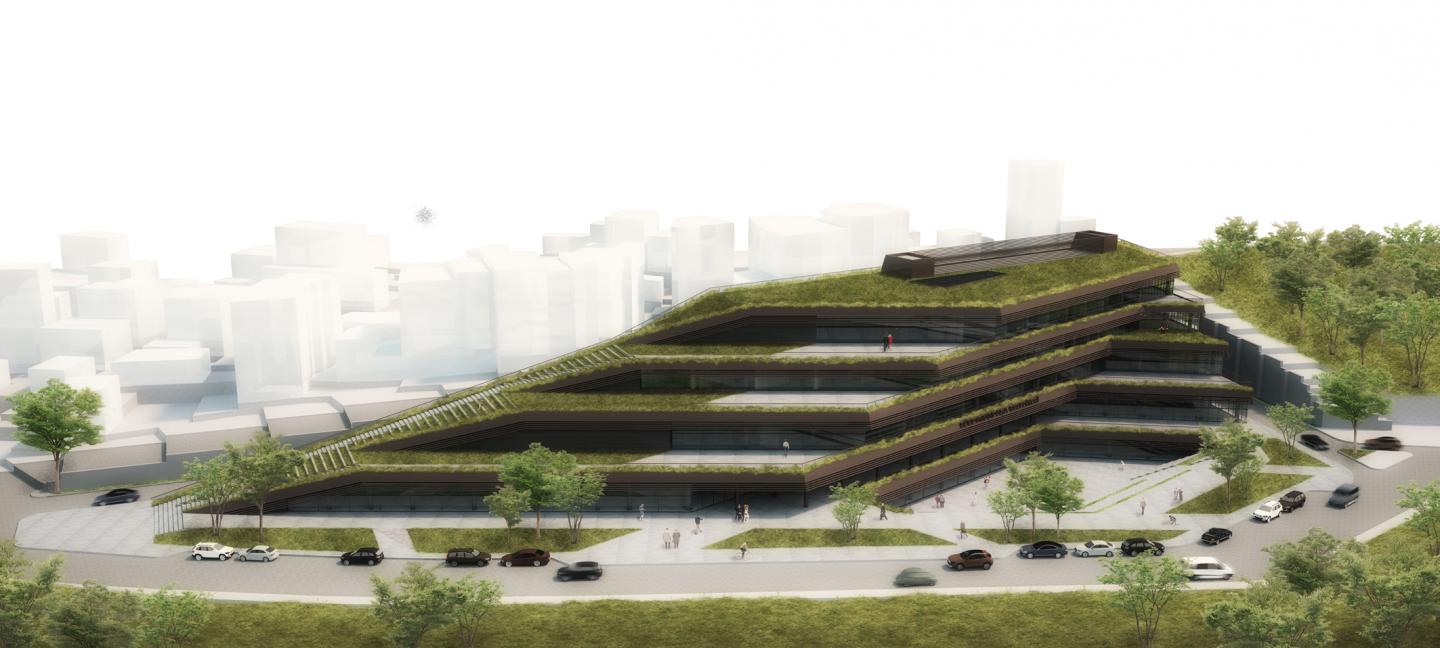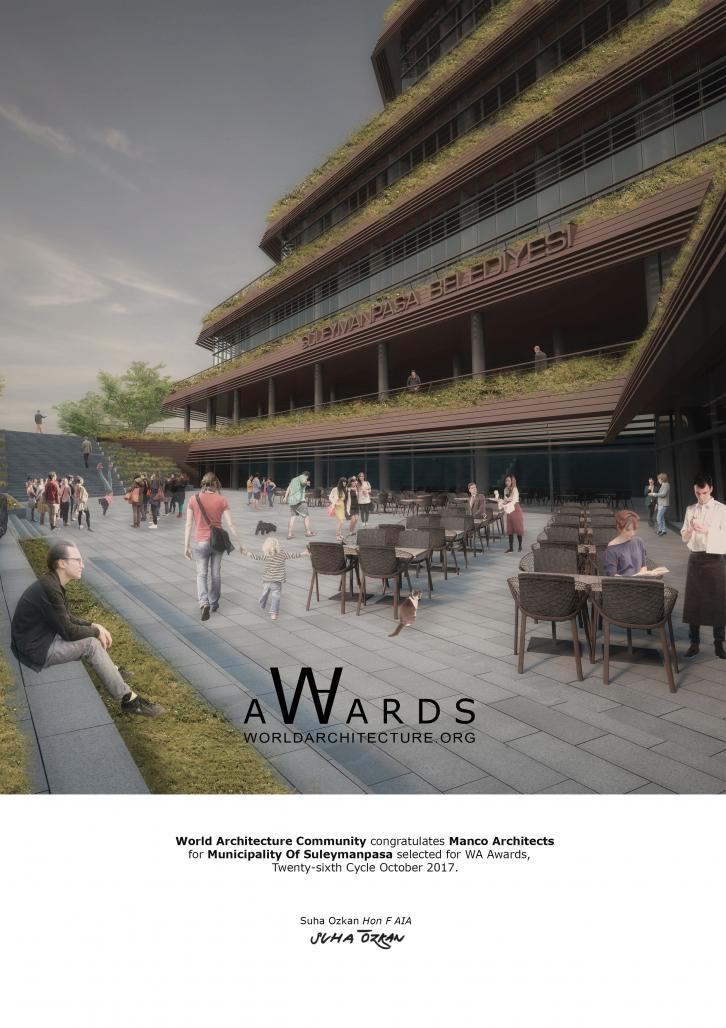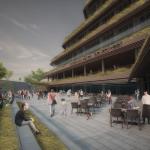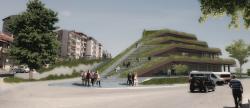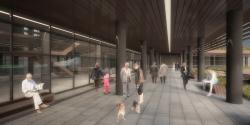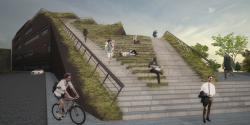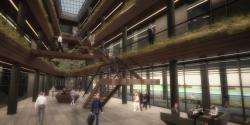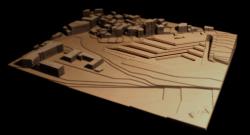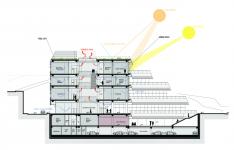When viewed from the sky it is noticed that the green tissue cuts through building islands and reaches the shore in the east of the center of Tekirdag, a city in Thrace region of Turkey surrounded by agricultural land on the north and Marmara Sea on the south. The competition plot is located right next to this intersection where the urban meets the rural. There the sloping topography is sliced with retaining walls reaching 14m height on the northern corner of the plot, in order to create a bus station on the same level with the avenue. The thought that emerged in response to those walls bordering the green and built areas has been the starting point of the architectural design: “Eliminating the walls of the dam so that the buildings from one side and the greenery from the other mix and flow toward the street level; recreating the destroyed part of the topography with the emerging hybrid tectonic pile.”
The functions of the building program were solved as floors with differing sizes stacked on top of the other according to parameters such as, the level of connection with the street, interrelations among the municipality units and load bearing structure concerns. The building mass was shaped as cascades parallel to the retaining walls, in order to refer to the slope of the topography.
By creating continuous and sloping roof surfaces, the grades of the building mass were connected with the street level on the western corner of the plot, so that the terrace areas were linked with the pedestrian circulation on the Sehit Yuzbasi Mayadagli Avenue. Except the walking and functional areas, the roofs were covered with vegetation, in order to visually unite the inaccessible green tissue of the cemetery on the east of the plot with the street. It was aimed that the roof surfaces that can be directly reached from the street will become public open areas where the city and sea vistas can be viewed.
It was predicted that the commercial areas, which occupy a substantial area of 2000m² in the program, will be retail and restaurant spaces open to the increasing public use of Sehit Yuzbasi Mayadagli Avenue. Accordingly, the commercial areas as well as the conference/dining halls are located close to the ground level with independent entrances from Sehit Yuzbasi Mayadagli Avenue. Likewise the municipality part was also planned to have direct contact with the street regarding both circulation and visual perception, in order to display qualities such as “transparent, community-centric, equal and just” mentioned in the foreword of the program.
A forecourt facing the main arrival direction and uniting with the neighboring green area was created on the east side of the plot by pushing the building to the setback border on the North. The open space was lowered to -4.73 level and half of the commercial area was solved in a way encircling the sunken public courtyard. A sheltered walkway reaching the main municipality entrance was created in the portion sliced off from the ground floor and lowered to the forecourt level. The municipality and the street were visually united with the fully transparent façade between the entrance hall and the colonnade created in front. Street and courtyard levels were connected with stairs parallel to the pedestrian axis. Both the looks and the use of the open space were enriched by integrating landscape and amphitheatre functions to the stairs entirely surrounding the plaza on the street side. It is anticipated that the forecourt, which is sheltered from the prevailing wind by the building mass, will serve as an open public space used day and night.
The municipality departments were lined along the façades within a depth enabling natural lighting. In order to maximize the penetration of sunlight into the interior of the building, an atrium void was opened up in the center. The horizontal and vertical circulation among municipality units was planned around the atrium so that users move through illuminated and vivid interior spaces while running into each other.
The mayor’s office and the municipal council were planned on the 3rd floor together with directly related departments. However, thanks to the positioning of the ground floor on the same level as Sehit Yuzbasi Mayadagli Street, even the highest floor of the building meets the highest level of Karlik Street ascending along the North side of the project site. By keeping the height of the building above the retaining wall at minimum, the views of residential buildings on Karlik Street were not completely obstructed. The terrace in front of the municipal council was connected with the street via sloping roofs so that public access to the highest office of the municipality was enabled. Principles such as, community-centric approach, equality and justice cited in the foreword of the program were architecturally expressed with the layered building mass respecting the neighboring urban context, as well as the open spaces of the project that the public can access at all floors.
On the southern side the building was enclosed with a fully transparent façade from floor to ceiling opening to the panorama and the street, whereas on the northern side facing the retaining walls horizontal openings above parapet level allowing maximum diffused daylight were preferred. The opaque surfaces on façades were clad with narrow bands of aluminium composite panels referring to the vernacular wood architecture of the city. The building was horizontally surrounded with vegetation via continuous plant pots facing south. Excessive heat gain and glare during summer were prevented with horizontal sunbreakers hung from the floor slabs alongside the southern façade.
Artificial HVAC costs were minimized by providing natural cross ventilation through operable windows on the façades, as well as the glass walls facing the atrium. The heated interior air will ascend through the gallery void and be exhausted through the automatic openings on the skylight.
A much higher level of thermal insulation than standard roof layers will be provided with the vegetation and earth used on the green roofs. It is also predicted that the green roofs will be habitated with local bird breeds. Plants that are adaptable to the climate and require minimum watering and maintenance will be preferred for the landscaping.
The rainwater collected from the roof surfaces and the surrounding landscaping into the large volume tank in the basement floor will be used for the watering of the plants, as well as closets and urinals.
2017
Ali Manço, Zuhtu Usta, Baris Demirsoy
Municipality of Suleymanpasa by Manco Architects in Turkey won the WA Award Cycle 26. Please find below the WA Award poster for this project.
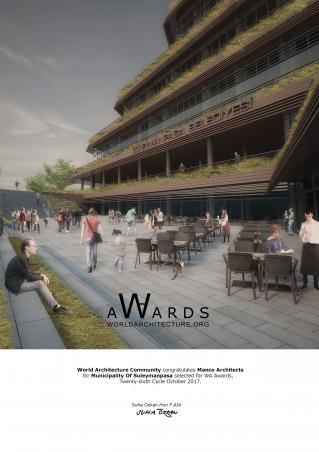
Downloaded 40 times.
Favorited 3 times
